North Country Girl: Chapter 13 — Food, Glorious Food
For more about Gay Haubner’s life in the North Country, read the other chapters in her serialized memoir. The Post will publish a new segment each week.
Every Duluth organization met over a breakfast or lunch (if not at the clubhouse bar), as parents and kids were expected to dine en famille. If it wasn’t Friday, dinner at the Haubners had a large meat component, along with a starch and at least two veg. Gravy arrived at the table often and in a barge. Even though I was a picky eater, I had my favorites: Beef tomato, which my mom had learned to make at a Chinese cooking class she took in Hawaii, and which resembled no Chinese dish ever. It was tinned tomatoes, strips of steak, and green peppers that had to be prepared in an electric skillet for authenticity. It made a brownish soy sauce gravy and was served over huge lovely beds of overcooked Uncle Ben’s Converted Rice. Chicken and dumplings boiled away for hours on the stove; it made a bland white gravy often served with egg noodles for extra starchiness. There were a few non-gravy menus.
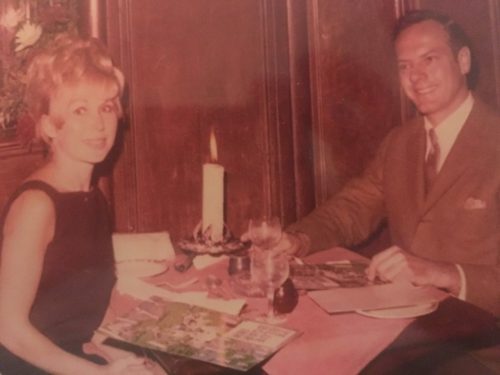
Mom rubbed the outside of immense pork roasts with a mixture of spices that made eating the salty crispy fat bits the best part. I failed the see the charms of the boiled dinner — ham or corned beef simmered with potato, cabbage, and onions into a uniformly grey mess, but I adored the required accompaniment of brown bread that came in a can — bread in a can! — thickly sliced and thickly covered with butter. In summer there were hamburgers, hot dogs, and steaks on the barbeque, overseen manfully by my dad (until he moved out and I was assigned to the grill); ketchup was the only condiment although there was usually a jar of sandwich pickles somewhere.
There were homemade chocolate chip cookies and banana bread and a crisp and flaky apple pan dowdy that was made with a pound of lard. I tried not to think about what exactly lard was even as my heart rose every time I saw that blue box peeking out of the brown paper grocery bag. Baked goods were washed down with milk from glass bottles, which appeared a few times a week in the silver Springhill Dairy box on the side of the house, a box adorned with a drawing of a cow who looked very contented.
Dinner was eaten in the dining room at 411 Lakeview (the banquette table in the remodeled kitchen was for breakfast, lunch, and the rare occasions my dad brought home take-out Chinese food). Memorable events at that long, highly polished mahogany table include my projectile vomiting as a result of my dad forcing me to eat a boiled brussels sprout (it took years for me to try one again, and even today I prefer them burnt to a crisp). Then there was the dinner party when our long-legged neighbor, Joe Kraft, who habitually teetered on the hind legs of his dining room chair, pushed his balancing act so far that he cracked the legs off the chair. He went sprawling to the floor and my mom flew into such a rage that I fled upstairs to my room.
Dinner parties were regular occurrences; Duluthians were great socializers. My mother held weekly bridge parties, setting up card tables in the living room, fixing a special dessert, and arranging tempting tiny nut cups at each place filled with cashews or waxy chocolate Brach’s Bridge Mix (“Don’t touch anything!”). My parents, those madcaps, had learned the Twist so they could show off at a dance party they threw in our basement after it had been de-ratted. My parents went out almost every Saturday, leaving Lani and me in the hands of a bored teenager who spent all evening on the phone. Only on those nights were Lani and I allowed to eat in front of the TV, dining on actual TV dinners. I loved the turkey one, even though when you took it out of the oven the cinnamon-y stewed apples were so hot they singed your tongue, while the so-called stuffing nestled under the paper-thin slices of white and dark meat remained ice cold. The upper right compartment of the tin foil tray contained whipped potatoes with absolutely no taste at all, so they were mixed with an equal amount of butter. The sitter reappeared at 10 to pick up the half eaten trays and shoo us to bed, where I lay awake, convinced that I’d never see my parents again.
When Lani passed the stage where she was enjoyed throwing fits so rabid that she sent everyone around her into fits as well, our parents started taking us out to dinner. There was the Fifth Avenue, with spindly tables and pink and black wallpaper depicting people carrying baguettes, riding bikes, and wearing berets. Every meal there began with a basket of popovers right from the oven, steam rising above the white cloth, so hot that butter melted immediately on them; a burnt tongue was a small price to pay for such loveliness. There was the Flame restaurant, down by the harbor, where they announced the names of ships that were crossing under Duluth’s “famous” aerial bridge. The Flame had a short man in a bellhop uniform stationed at the door and an immense and frightening lobster tank. There was the Pickwick, long and dark and medieval, with stained glass windows on the side and a view of Lake Superior from the back. I loved their chicken, with its salty blackened skin, ignoring my mother’s “You can get grilled chicken at home” stink eye. Starting about two months before Christmas, the Pickwick bar offered Tom and Jerry’s. A drink named after a cartoon! A Tom and Jerry was warm, heavily spiced eggnog fortified with brandy or rum. I was allowed small swigs; it was the nectar of the gods.
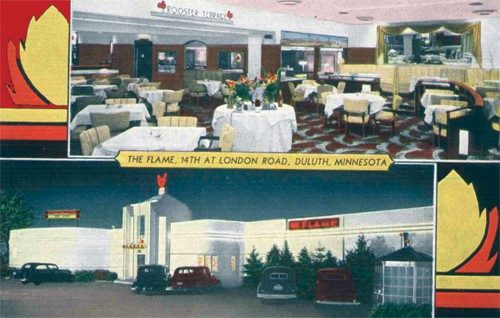
The swankiest restaurant was the London House, with cut glass dishes of celery and carrot sticks and black olives, tri-part stainless steel salad dressing servers with Blue Cheese, Thousand Island, and French (I used French by the teaspoon as it was the only one that didn’t make me puke to look at it), and baked potatoes the size of cantaloupes, that came with their own servers holding sour cream, bacon bits, grated Cheddar, and diced onions. Everyone got steak or prime rib or lamb chops or fried shrimp. We ate ensconced in huge red leather booths; my parents knew everyone who passed by our table. We girls were supposed to order something not too expensive, eat all of it, and shut the hell up.
Every once in a while a tinkle of piano and song would drift up from Tin Pan Alley, a mysterious basement piano bar where children were strictly forbidden. This joint was the favorite destination of my mother’s pals Karin Luster and Gloria Hovland, who imagined themselves glamourous chanteuses making a pit stop in Duluth on their way to stardom. Gloria also wrote songs, which she sent out to agents, hoping one of them would catch the ear of Tony Bennett or Perry Como. She was convinced that the music publishers were stealing her melodies and would cock her head like a robin anytime she her a few bars of Muzak.
In Duluth’s bustling downtown there was The Chinese Lantern, which had huge portions of blandly delicious Cantonese food and the best prime rib. There was also the dreaded Jolly Fisher, permeated with a nauseating smell of fish, which made me so ill that I couldn’t swallow as much as a french fry. Not wanting to repeat the brussels sprout episode, my parents stopped taking Lani and me along when they ate there, leaving us at home to enjoy our TV dinners.
I think our favorite meals were the ones we ate when my dad wasn’t home. Pretty much everything tasted good in Duluth in the 1960s: there weren’t a lot of artificial flavors or preservatives, no microwaves, and the only sweetener was cane sugar. At drive-ins (it wasn’t fast food then as it wasn’t especially fast) everything was prepared fresh right when you ordered it. We’d sit and wait for our Kentucky Fried Chicken (we would have been mystified by the initials KFC): watching the fry cook in the little paper hat take the pieces of chicken we ordered (Lani and I liked drumsticks), dredge them in batter, and sink them in the Fryolater. We took the waxy bucket home, almost too hot to hold, perfuming the car interior with eleven different herbs and spices. The mashed were real potatoes, the pallid gravy slightly floury, the biscuits were buttery, light, and fluffy, the cole slaw uneaten. I have no idea when everything went so terribly wrong.
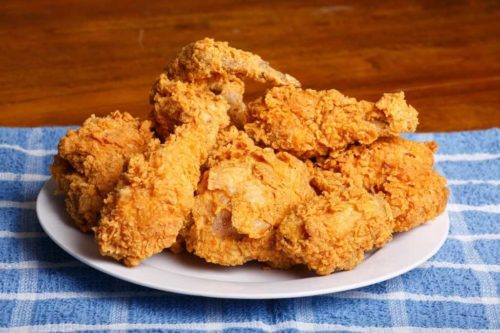
For my mom to buy Kentucky Fried Chicken we needed ready cash, which was always in short supply at our home. But if we went through all our coat pockets, the couch seats, and the bottom of my mom’s purse, we could come up with enough change to go to the London Inn and get 15 cent hamburgers, fries, and onion rings. The London Inn’s parking lot was always filled with cars and teenagers and blasting radio music, all tuned to the same station, WEBC.
The onion rings were even better and the burgers grilled over an open flame at Nick’s, but Nick’s was in the West End and my mother was loathe to drive the 20 minutes. If the London Inn counter was eight deep in teenagers, we would head to the A&W, where a brown-and-white costumed carhop took our orders and returned with a heaping tray of food and once in a great while, root beer floats, which she perched precariously on the half-opened car window. More than once, my mother got splattered with root beer, melted ice cream, and ketchup when she upset the delicate balance created by three heavy glass mugs.
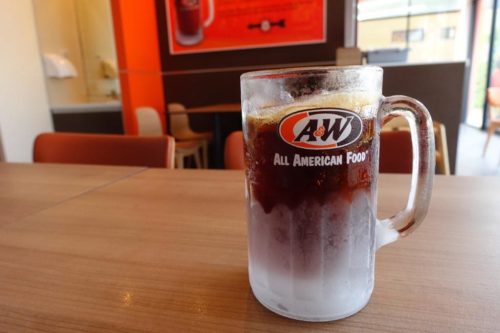
The A&W’s floats were good, but there was really only one destination for ice cream: Bridgeman’s. A dime bought a single scoop cone. A Tin Roof Sundae, with chocolate sauce and roasted peanuts, was eighty cents. Bridgeman’s had fresh peach ice cream, studded with pale pink chunks of frozen fruit, but only in August. The shakes and malts came straight from the blender in a tall, heavy glass and topped with whipped cream, along with some extra in the silver blender jar to make sure you achieved maximum ice cream freeze head. An evil second cousin had showed me how if you dipped the end of your paper straw end into the malt, you could shoot it up to the ceiling and it would stick. (This was the same distant relation who also gave me a lit firecracker to hold.) I would not have dared to so sully the pristine white and stainless steel interior of Bridgeman’s.
News of the Week: 5 Rockwell Paintings, 1 Howard Johnson’s, and 11 Herbs and Spices
Norman Rockwell on Tour
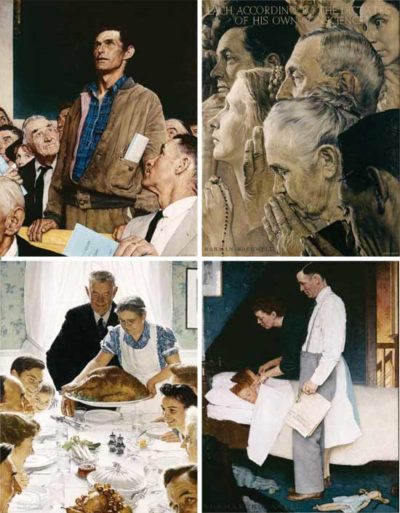
© SEPS.
They’re not the originals, but it’s great to see that quality copies of five classic Norman Rockwell works will be on display at several federal courthouses in Massachusetts this fall.
Copies of “Four Freedoms” and “Golden Rule” will be on display at federal courthouses in Boston, Springfield, and Worcester. The paintings will first be displayed in Boston on September 23, and then in Springfield on October 6 and in Worcester on October 11.
This year marks the 75th anniversary of President Franklin Roosevelt’s “Four Freedoms” speech, which inspired Rockwell to create that series of paintings. In the speech, FDR talked about the freedoms everyone should have: Freedom of Speech, Freedom of Worship, Freedom from Want, and Freedom from Fear.
We should update that list with a fifth: Freedom from the Kardashians.
The Solo Hojo
Back in July of 2015, I told you about the last two remaining Howard Johnson’s. Come next week, there will only be one left.
The Howard Johnson’s in Bangor, Maine, is closing forever next Tuesday. That means that there’s only one Hojo’s left, in Lake George, New York. Let’s hope that somehow, some way, that location is able to stay open forever. I’m sick of iconic things closing or going away or changing.
RIP Gene Wilder, Jeanne Martin, and Marvin Kaplan
To put it bluntly, Gene Wilder was one of the funniest men in the movies. He was in a bunch of classic comedies, including Young Frankenstein, Blazing Saddles, The Producers, and Silver Streak. He also gave one of the all-time great performances in Willy Wonka and the Chocolate Factory, which I think I’ve seen approximately 40 times.
Wilder passed away at the age of 83 of complications from Alzheimer’s. Mel Brooks paid tribute to his friend on Twitter:
Gene Wilder-One of the truly great talents of our time. He blessed every film we did with his magic & he blessed me with his friendship.
— Mel Brooks (@MelBrooks) August 29, 2016
Wilder passed away with his family holding his hand, listening to “Somewhere Over The Rainbow.”
Just a few weeks after her son Ricci died, Jeanne Martin has passed away at the age of 89. She was the ex-wife of Dean Martin (Jerry Lewis was the best man at their 1949 wedding) and had a career as a model.
Marvin Kaplan did a lot of TV shows and movies, and I guess a lot of us will remember him as one of the gas station attendants (along with Arnold Stang) who gets into a big fight with Jonathan Winters in It’s A Mad, Mad, Mad, Mad World. He was also the voice of Choo-Choo on Top Cat and was a regular on the TV series Alice. Other movies he appeared in include Adam’s Rib, The Nutty Professor, and Freaky Friday, and he appeared in TV shows like I Dream of Jeannie, My Three Sons, ER, Becker, and MacGyver.
Kaplan passed away late last week at the age of 89.
11 Herbs and Spices
Was the secret “11 herbs and spices” recipe for Kentucky Fried Chicken just published in The Chicago Tribune?
That’s what people are asking after reporter Jay Jones met with Sanders’ nephew Joe Ledington during a trip to the Harland Sanders Cafe and Museum in Corbin, Kentucky. Ledington showed Jones a family scrapbook that had a piece of paper inside that seems to have the complete recipe.
Ledington later told Jones that he now felt bad about showing the recipe. It’s not in his uncle’s handwriting, but he swears the recipe is authentic because he used to help his uncle mix the spices when he was a kid.
Of course, officials at KFC say the recipe is not authentic. The Chicago Tribune did a taste test with KFC they bought, and here are the results.
Here’s Colonel Sanders on a 1963 episode of What’s My Line? It’s rather confusing because by this time there were already 600 Kentucky Fried Chicken locations. Wasn’t his name and/or appearance known by people in 1963?
Maybe that fame came a few years later.
New Books
In addition to the nonfiction and fiction picks in the new issue of The Saturday Evening Post, here are a few other new books that might be worth your time:
Whistlestop, by John Dickerson
The host of CBS’s Face the Nation has a ridiculously entertaining look at important moments from election years past. The perfect thing to read during this crazy 2016 election, because you’ll learn that some rather interesting things happened in past elections, too.
Best. State. Ever. A Florida Man Defends His Homeland, by Dave Barry
Florida gets a bad rap — often from Dave Barry himself — but in his book he attempts to defend the Sunshine State. (Available September 6.)
She Made Me Laugh: My Friend Nora Ephron, by Richard Cohen
The Washington Post columnist writes a love letter to his close friend. He calls it a “third-person memoir,” and it includes interviews with Tom Hanks, Mike Nichols, Meryl Streep, and many others. (Available September 6.)
The French Chef in America, by Alex Prud’homme
The co-author of the Julia Child biography My Life in France follows up with a sort-of part 2, where he talks about Child’s success on television and how she changed the world of cooking. (Available October 4.)
Young Frankenstein: The Story of the Making of the Film, by Mel Brooks
It’s odd timing, but to celebrate the life of Gene Wilder, you could pick up this book that goes behind the scenes. (Available October 18.)
This Week in History: VJ (Victory Over Japan) Day, 1945
It’s celebrated on August 15 in the United Kingdom, because that was the day of the official surrender by Japan, but it’s officially celebrated in the United States on September 2, the day the surrender agreement was signed.
This Week In History: The Death of Princess Diana, August 31, 1997
The night Princess Diana died I was watching MSNBC. I went to bed but woke up a couple of hours later and decided to turn on the TV again for some reason. That’s when I saw anchor Brian Williams announce her death to viewers.
September is National Rice Month
Like a lot of people, I make a lot of rice in the fall and winter. So I guess it’s good that September kicks things off as National Rice Month.
Here’s a recipe for Chicken Rice Roger, one of the great recipes in my favorite cookbook, Peg Bracken’s The I Hate To Cook Book. And here’s one for Red Rice Stuffing with Dried Fruit. We should include a recipe for classic arancini (or rice balls), and here’s a video where Martha Stewart shows you how to make the perfect white rice. That’s right, PERFECT! Because it’s Martha Stewart.
Next Week’s Holidays and Events
Newspaper Carrier Day (September 4)
It’s celebrated on a Sunday this year, but even if you don’t get a paper on Sunday, make sure you give your carrier a little something extra this week. It will surprise him or her, and you’ll also be supporting print!
Labor Day (September 5)
Was it McGuire or Maguire who came up with the idea for the holiday?
NFL season starts (September 8)
The Carolina Panthers play the Denver Broncos in the first game of the season, which airs on NBC at 8:30 p.m. Here’s the full schedule.